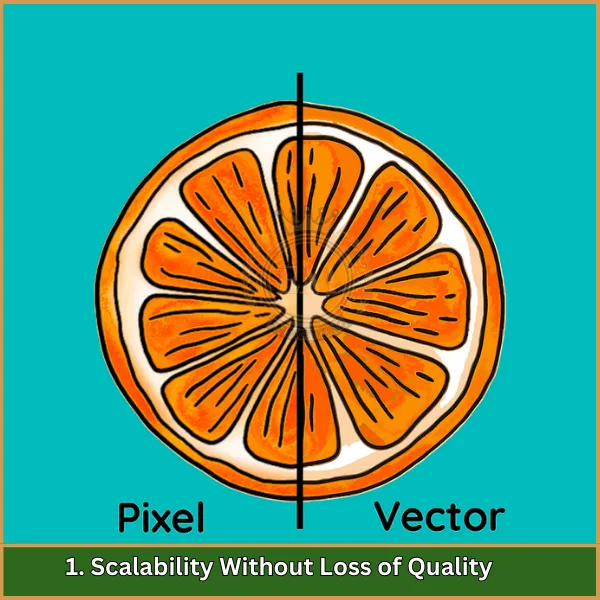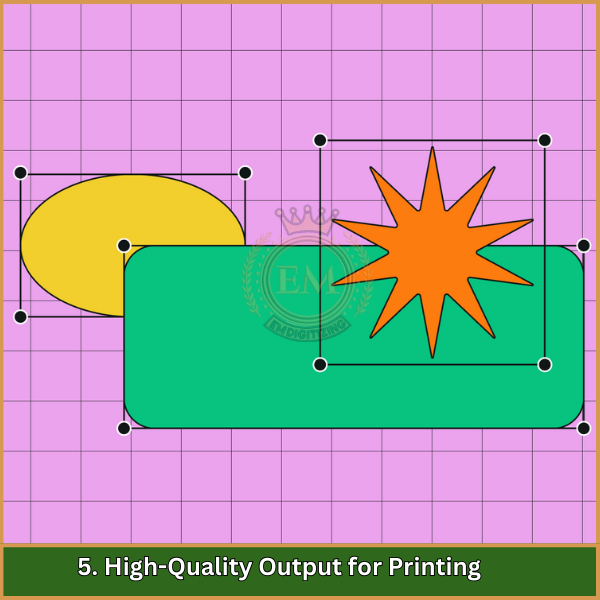Quand il s'agit de conception, connaître les avantages et les inconvénients des images vectorielles peut faire une grande différence. Ils sont appréciés pour leur capacité à évoluer sans perdre en clarté., ce qui les rend parfaits pour des projets tels que des logos et des icônes.
Cependant, ils ont leurs inconvénients, comme ne pas être idéal pour des images détaillées ou réalistes. En outre, la création et l'édition de fichiers vectoriels nécessitent souvent des logiciels et des compétences spécialisés.
Dans cet article, nous explorerons les avantages et les inconvénients des images vectorielles pour vous aider à déterminer si elles constituent le bon choix pour votre prochain projet.

Quels sont les avantages et les inconvénients des images vectorielles?
Avantages des images vectorielles
Les avantages de l'utilisation images vectorielles en font un choix idéal pour divers projets de conception, surtout là où l'évolutivité et la clarté sont essentielles.
- Évolutivité sans perte de qualité
- Tailles de fichiers plus petites
- Facile à modifier et à manipuler
- Compatibilité sur différentes plates-formes
- Sortie de haute qualité pour l'impression
1. Évolutivité sans perte de qualité

L'un des principaux avantages est que les fichiers vectoriels peuvent être redimensionnés à l'infini sans perte de qualité.. Que le design soit agrandi pour un panneau publicitaire ou réduit pour une carte de visite, ça reste net et clair. Cela les rend idéaux pour les logos et autres designs qui nécessitent une flexibilité de taille..
2. Tailles de fichiers plus petites
Les fichiers vectoriels sont généralement beaucoup plus petits que les images raster haute résolution, car ils utilisent des formules mathématiques au lieu de pixels.. Cette taille de fichier plus petite les rend plus faciles à stocker, partager, et chargez-le rapidement sur différentes plates-formes et appareils, améliorer l'efficacité du flux de travail.
3. Facile à modifier et à manipuler

L'édition de graphiques vectoriels est simple, as each component—whether it’;c'est une forme, doubler, ou courbe - peut être ajusté individuellement sans affecter l'ensemble du design. Cette flexibilité permet aux concepteurs d'apporter des modifications rapides, faisant des fichiers vectoriels une option pratique pour les projets complexes.
4. Compatibilité sur différentes plates-formes
Les fichiers vectoriels sont compatibles avec la plupart des logiciels de conception, permettant un transfert et une collaboration faciles entre différentes plateformes. Que vous travailliez avec Adobe Illustrator, CorelDRAW, ou un autre programme, le fichier s'ouvrira sans problème, le rendant polyvalent pour les designers.
5. Sortie de haute qualité pour l'impression

Quand il s'agit d'imprimer, les graphiques vectoriels fournissent des résultats de haute qualité. Since they don’;pixelliser, ils fournissent du tranchant, des impressions nettes pour tout, des petites étiquettes aux grandes bannières, assurant une finition professionnelle et polie.
Inconvénients des images vectorielles
Les inconvénients de l'utilisation images vectorielles devrait être considéré, especially if you’;je travaille sur des conceptions qui nécessitent beaucoup de détails ou de réalisme.
- Détails limités pour les images complexes
- Pas idéal pour les images photoréalistes
- Exigences en matière de logiciels et de compétences
- Limité par les formats de fichiers
- Inefficace pour certains types de conception
1. Détails limités pour les images complexes
Ils sont parfaits pour les conceptions simples, mais ils ont du mal lorsqu'il s'agit d'images très détaillées ou complexes, comme des photographies ou des œuvres d'art complexes. Puisque les vecteurs sont constitués de formes comme des lignes et des courbes, they can’;N'affiche pas les détails fins comme les ombres ou les textures des images tramées (fait de pixels) peut facilement afficher.
2. Pas idéal pour les images photoréalistes
Alors que les vecteurs sont parfaits pour des choses comme les logos et les icônes, they aren’;pas bon pour créer images photoréalistes. Vectors can’;pour reproduire la profondeur, texture, ou l'aspect naturel d'une vraie photographie. Si vous avez besoin de créer ou de travailler avec une image réaliste, un format d'image raster comme JPEG ou PNG est un meilleur choix.
3. Exigences en matière de logiciels et de compétences

La création de fichiers vectoriels nécessite un logiciel de conception spécial, comme Adobe Illustrator ou CorelDRAW. Ces programmes peuvent être coûteux, et ils ont souvent une courbe d'apprentissage abrupte, ce qui peut être difficile pour les débutants. Vous avez besoin de quelques compétences techniques pour utiliser pleinement ces outils, ce qui pourrait constituer un obstacle pour les utilisateurs occasionnels ou les petites entreprises.
4. Limité par les formats de fichiers
Bien que les fichiers vectoriels soient très utiles, they aren’;t pris en charge par tous les programmes ou plates-formes. Les formats comme SVG ou EPS peuvent ne pas être entièrement compatibles avec certains logiciel de conception ou navigateurs Web. Cela signifie que vous devrez peut-être les convertir dans des formats plus largement acceptés., ce qui peut parfois affecter la qualité ou la fonctionnalité de l'image.
5. Inefficace pour certains types de conception
Ils ne constituent pas toujours le meilleur choix pour tous les projets de conception. Par exemple, si votre projet implique beaucoup de conceptions complexes, dégradés, ou des transitions de couleurs douces, les vecteurs peuvent être inefficaces et ne pas produire l’effet visuel souhaité. Dans de tels cas, les images raster peuvent gérer ces détails plus efficacement et plus facilement.
Derniers mots
Comprendre les avantages et les inconvénients des images vectorielles est important pour choisir le bon type d'image pour votre conception.. Ils sont parfaits pour redimensionner sans perdre en qualité, mais ils ne sont peut-être pas le meilleur choix pour des images très détaillées ou réalistes.
Si vous recherchez des services professionnels d’art vectoriel, Numérisation EM est là pour aider! Nous fournissons un service rapide, prix abordables, et des designs de haute qualité qui répondent à vos besoins. Qu'il s'agisse d'un logo ou de tout autre projet vectoriel, nous avons ce qu'il vous faut. Plus, profitez d'un spécial 50% remise pour les premiers clients! Laissez-nous donner vie à vos idées avec de superbes designs vectoriels.
FAQ
Ils sont principalement utilisés pour les logos, illustrations, et les mises en page d'impression car elles peuvent être redimensionnées sans perte de qualité, ce qui les rend idéaux pour les petits et grands formats.
Des exemples courants de fichiers vectoriels incluent les logos d'entreprise, plans architecturaux, et illustrations numériques créées dans des logiciels comme Adobe Illustrator.
Les types d’images d’art vectoriel les plus courants sont SVG (Image Vectorielle), PSE (PostScript encapsulé), et PDF (Portable Document Format), qui sont largement utilisés sur divers médias numériques et imprimés.
